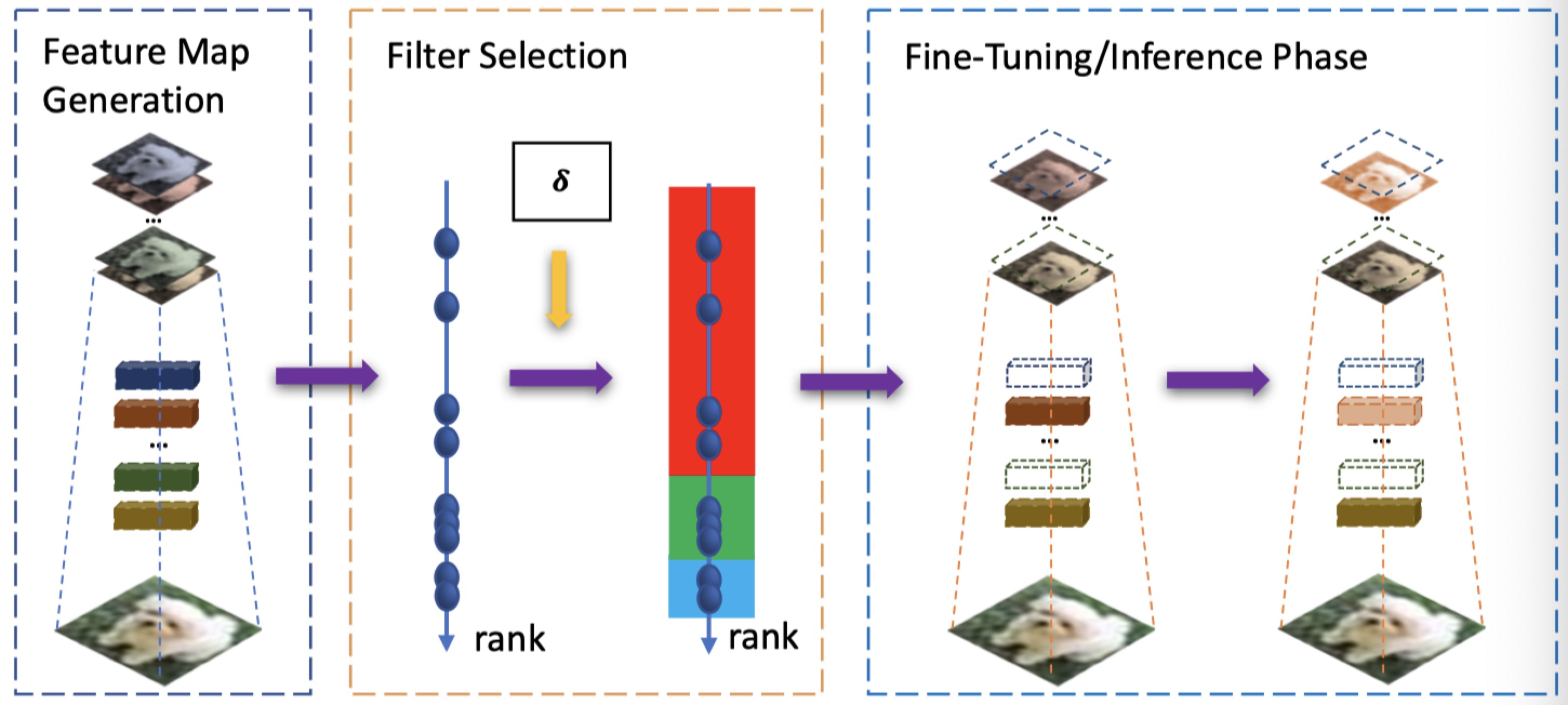HRank: Filter Pruning using High-Rank Feature Map (Link) .
.
Pytorch implementation of HRank (CVPR 2020, Oral).
This repository was what we used during the preparation of CVPR 2020. You can enjoy it!
A better version of HRank (in both fine-tuning efficiency and accuracy performance) are released at HRankPlus. It is highly suggested!
Framework of HRank. In the left column, we first use images to run through the convolutional layers to get the feature maps. In the middle column, we then estimate the rank of each feature map, which is used as the criteria for pruning. The right column shows the pruning (the red filters), and fine-tuning where the green filters are updated and the blue filters are frozen.
Any problem, please contact the authors via emails: lmbxmu@stu.xmu.edu.cn or ethan.zhangyc@gmail.com. Do not post issues with github as much as possible, just in case that I could not receive the emails from github thus ignore the posted issues.
If you find HRank useful in your research, please consider citing:
@inproceedings{lin2020hrank,
title={HRank: Filter Pruning using High-Rank Feature Map},
author={Lin, Mingbao and Ji, Rongrong and Wang, Yan and Zhang, Yichen and Zhang, Baochang and Tian, Yonghong and Shao, Ling},
booktitle={Proceedings of the IEEE/CVF Conference on Computer Vision and Pattern Recognition (CVPR)},
pages={1529--1538},
year={2020}
}
In this code, you can run our models on CIFAR-10 and ImageNet dataset. The code has been tested by Python 3.6, Pytorch 1.0 and CUDA 9.0 on Ubuntu 16.04.
python rank_generation.py \
--resume [pre-trained model dir] \
--arch [model arch name] \
--limit [batch numbers] \
--gpu [gpu_id]
For the ease of reproducibility. we provide some of the experimental results and the corresponding pruned rate of every layer as belows:
Attention! The actual pruning rates are much higher than these presented in the paper since we do not count the next-layer channel removal (For example, if 50 filters are removed in the first layer, then the corresponding 50 channels in the second-layer filters should be removed as well).
| Params | Flops | Accuracy |
|---|---|---|
| 2.64M(82.1%) | 108.61M(65.3%) | 92.34% |
python main.py \
--job_dir ./result/vgg_16_bn/[folder name] \
--resume [pre-trained model dir] \
--arch vgg_16_bn \
--compress_rate [0.95]+[0.5]*6+[0.9]*4+[0.8]*2 \
--gpu [gpu_id]| Params | Flops | Accuracy |
|---|---|---|
| 0.49M(42.4%) | 62.72M(50.0%) | 93.17% |
python main.py \
--job_dir ./result/resnet_56/[folder name] \
--resume [pre-trained model dir] \
--arch resnet_56 \
--compress_rate [0.1]+[0.60]*35+[0.0]*2+[0.6]*6+[0.4]*3+[0.1]+[0.4]+[0.1]+[0.4]+[0.1]+[0.4]+[0.1]+[0.4] \
--gpu [gpu_id]Note that, in the paper, we mistakenly regarded the FLOPs as 148.70M(41.2%). We apologize for it and We will update the arXiv version as soon as possible.
| Params | Flops | Accuracy |
|---|---|---|
| 1.04M(38.7%) | 156.90M(37.9%) | 94.23% |
python main.py \
--job_dir ./result/resnet_110/[folder name] \
--resume [pre-trained model dir] \
--arch resnet_110 \
--compress_rate [0.1]+[0.40]*36+[0.40]*36+[0.4]*36 \
--gpu [gpu_id]| Params | Flops | Accuracy |
|---|---|---|
| 0.66M(36.5%) | 167.41M(40.8%) | 94.24% |
python main.py \
--job_dir ./result/densenet_40/[folder name] \
--resume [pre-trained model dir] \
--arch densenet_40 \
--compress_rate [0.0]+[0.1]*6+[0.7]*6+[0.0]+[0.1]*6+[0.7]*6+[0.0]+[0.1]*6+[0.7]*5+[0.0] \
--gpu [gpu_id]| Params | Flops | Accuracy |
|---|---|---|
| 1.86M(69.8%) | 0.45B(70.4%) | 94.07% |
python main.py \
--job_dir ./result/googlenet/[folder name] \
--resume [pre-trained model dir] \
--arch googlenet \
--compress_rate [0.10]+[0.8]*5+[0.85]+[0.8]*3 \
--gpu [gpu_id]| Params | Flops | Acc Top1 | Acc Top5 |
|---|---|---|---|
| 13.77M | 1.55B | 71.98% | 91.01% |
python main.py \
--dataset imagenet \
--data_dir [ImageNet dataset dir] \
--job_dir./result/resnet_50/[folder name] \
--resume [pre-trained model dir] \
--arch resnet_50 \
--compress_rate [0.2]+[0.8]*10+[0.8]*13+[0.55]*19+[0.45]*10 \
--gpu [gpu_id]After training, checkpoints and loggers can be found in the job_dir. The pruned model will be named [arch]_cov[i] for stage i, and therefore the final pruned model is the one with largest i.
python cal_flops_params.py \
--arch resnet_56_convwise \
--compress_rate [0.1]+[0.60]*35+[0.0]*2+[0.6]*6+[0.4]*3+[0.1]+[0.4]+[0.1]+[0.4]+[0.1]+[0.4]+[0.1]+[0.4]python evaluate.py \
--dataset [dataset name] \
--data_dir [dataset dir] \
--test_model_dir [job dir of test model] \
--arch [arch name] \
--gpu [gpu id]optional arguments:
--data_dir dataset directory
default='./data'
--dataset dataset name
default: cifar10
Optional: cifar10', imagenet
--lr initial learning rate
default: 0.01
--lr_decay_step learning rate decay step
default: 5,10
--resume load the model from the specified checkpoint
--resume_mask mask loading directory
--gpu Select gpu to use
default: 0
--job_dir The directory where the summaries will be stored.
--epochs The num of epochs to train.
default: 30
--train_batch_size Batch size for training.
default: 128
--eval_batch_size Batch size for validation.
default: 100
--start_cov The num of conv to start prune
default: 0
--compress_rate compress rate of each conv
--arch The architecture to prune
default: vgg_16_bn
Optional: resnet_50, vgg_16_bn, resnet_56, resnet_110, densenet_40, googlenet
Additionally, we provide the pre-trained models used in our experiments.
Vgg-16 | ResNet56 | ResNet110 | DenseNet-40 | GoogLeNet
